Trying to figure out the difference between microgreens vs sprouts can be a difficult task, especially if you’re not familiar with the two.
When you consider the fact that microgreens and sprouts are essentially the same thing, just with two variables, you can understand the confusion.
Knowing the difference between microgreens and sprouts, will help you make a more informed decision about which one you will want to grow and consume.
What is the Difference Between Microgreens and Sprouts
Microgreens and sprouts are grown from the same types of seed and are essentially the same thing. If you’re eating a radish microgreen or a radish sprout, it’s still the sprout or offspring of a radish plant.
Seeds grown as microgreens vs. sprouts are the same plant species but at different stages of development. So you can use the same broccoli seeds, for example, and grow half of them as microgreens and half of them as sprouts.
What Are Sprouts?
Sprouts are seeds that have barely germinated, and when you consume them you are consuming the seed, roots, and initial growth.
What Are Microgreens?
Microgreens are immature plants produced from the seeds of edible plants such as vegetables, cereals and herbs.
Differences in Growing Microgreens vs Sprouts
Besides the stage in which the plant is consumed, there are a few other differences in growing microgreens vs sprouts:
- How they’re grown
- Length of time to grow
- Harvesting process
- Ability to regrow
- Part of plant eaten
How Are Microgreens Grown?
Microgreens are grown in soil or other growing medium, and the stems and leaves of these plants can be consumed. For microgreens, you don’t consume the roots or what is below the surface of the growing medium. Instead, you cut the tiny plant seedling off at just above the soil level, to harvest the leaves and the above-ground stem.
While microgreens take a little extra set up to grow, they’re easy to harvest and some can even continue growing on again for another cycle or two.
Microgreens can be grown in soil or alternative growing mediums that take a little more time to set up, but less time in daily processing, as they do not require rinsing, like sprouts.
When growing microgreens, you just need to keep the growing medium moist and once they’re sprouting, misting or watering as needed to keep them moist.
Harvesting and Eating Microgreens
To harvest microgreens, you can clip handfuls with scissors near the base of the plant, much like cutting grass by hand.
With microgreens, you only consume the vegetable portion of the plant, not the seed or roots.
How Are Sprouts Grown?
Sprouts are germinated in water, oten in sprouting kits that in the form of jars or stackable trays. They require rinsing twice daily.
The seeds and stems of these can be eaten. The hulls may also be consumed as it’s nearly impossible to rinse them all away.
How Long Does It Take Sprouts to Grow?
The average time for sprouts to grow is 3-5 days, however, it varies by type of seed.
Harvesting and Eating Sprouts
Once sprouts are ready, at around 1-2″ long, with a nice green coloration, it’s time for a final rinse and drain and they’re ready to eat.
Sprouts can be stored in a ziplock bag loosely surrounded by a paper towel to absorb excess moisture. The sprouts and paper towel can be moist but should not be wet or they’ll get mushy and spoil.
Can You Eat Sprout Hulls?
While the outer coating of seeds may not contribute notable nutrients, they’re not harmful and even contribute beneficial fiber.[1]https://sproutpeople.org/growing-sprouts/sprouting-basics/de-hulling/
Those with issues such as diverticulitis may need to avoid the hulls, so discern according to your health and your doctor’s recommendations.
Microgreens Vs Sprouts Nutrition
When comparing microgreens vs sprouts nutrition, both have their own benefits and are considered valuable nutrient rich superfoods.
Sprouts have more pectins, amino acids, and sugars than microgreens.
However, microgreens have higher amounts of chlorophyll, organic acid, and carotenoids without the sugars. Additionally, microgreens have higher anti-cholinergic and anti-diabetic properties than sprouts.
Sprouts Nutrients – Sprouts Are Higher in:
- Amino acids
- Antioxidants
- Pectins
- Sugars
Nutrient Rich Superfood Sprouts Include:
- Broccoli
- Lentil
- Radish
Microgreens Nutrients – Microgreens Are Higher in:
- Acids
- Antidiabetic
- Carotenoids
- Chlorophylls
Nutrient Rich Superfood Microgreens Include:
REFERENCE: Oct. 12, 2020 study on Sprouts vs. Microgreens (https://www.ncbi.nlm.nih.gov/pmc/articles/PMC7587365/#abstract-1title))
Are Microgreens Safer To Eat Than Sprouts?
Because of the way it is grown, microgreens are considered safer to eat than sprouts. Microgreens are grown in soil where there is more light and ventilation required. This reduces the chance of bacteria growing.
Just like with any other vegetables, however, microgreens and sprouts are generally safe to eat if they are grown and processed properly. This will greatly reduce the number of food borne pathogens forming on the vegetables.
Microgreens have not yet been linked to any food borne illness outbreaks as of yet.
[2]https://phys.org/news/2022-07-microgreens-vulnerability-pathogens-characterized.amp
Sprouts are a different story, however. Perhaps you recall the sprouts scare that caused them to not be available commercially for some time.
According to the CDC, between the years 2011, nine foodborne illness outbreaks occurred from consuming sprouts. Because of this, the CDC has listed sprouts as a high risk food.
[3]https://www.clemson.edu/extension/food/food2market/factsheets/7-the-food-safety-of-sprouts-factsheets.html
However, sprouts are once again back in stores and homes. Wth proper rinsing and cleanliness and mold and bacterial prevention practices, the risks are minimal.
What is the Difference Between Microgreens and Sprouts?
Here’s a Summary of Microgreens vs Sprouts:
Microgreens
- Begin as sprouts and develop primary leaves called cotyledons
- Can be sown in a watery grow mat like sprouts, or in dirt.
- Microgreens are harvested by trimming them near the base of the stem.
- Ready to harvest in 1-3 weeks, depending on the vegetable variety used
Sprouts
- Grown only in water
- Seed, stem and leaves are all edible
- Are consumable sooner than many microgreens at around 4 days on average
- Most varieties ready to harvest in 3-7 days
Why Microgreens and Sprouts Both Considered a Superfood
Research reveals the nutritive value of microgreens to be many times that of their mature version – some even 40 times more than the nutritive value of the same plant at maturity.
SOURCE: Microgreens studies[4]https://extension.psu.edu/growing-microgreens[5]https://nfsc.umd.edu/news/mighty-microgreens[6]https://pubs.acs.org/doi/full/10.1021/jf300459b

We are an online gardening publication sharing all things garden related! Including urban farming, family gardening, homesteading, gardening for profits, and more. We’re all about growth!
References

